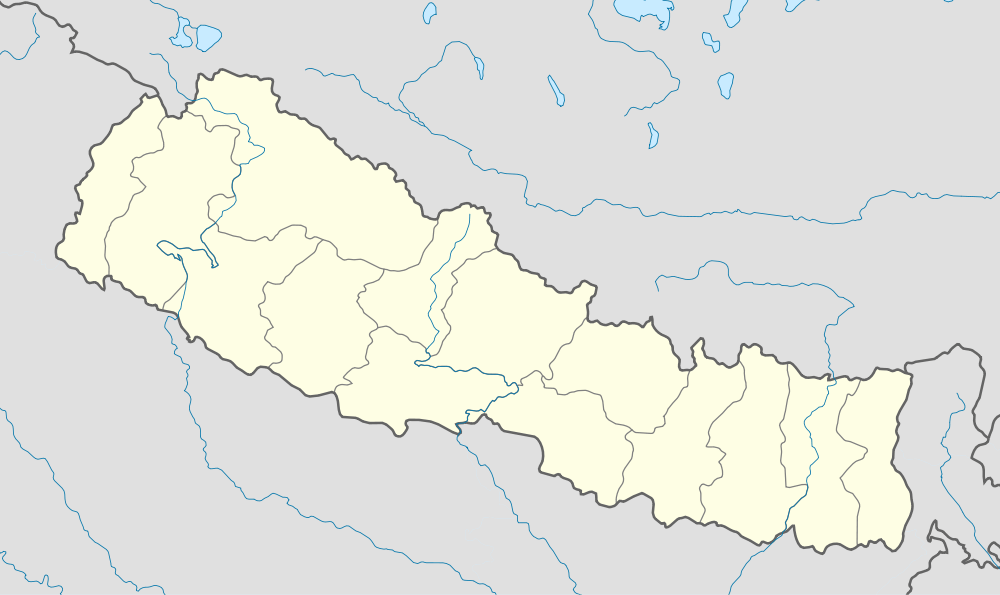Lo Manthang
| Lo Manthang लोमान्थाङ | |
|---|---|
| city | |
|
Lo Manthang | |
| Nickname(s): city of wall | |
 Lo Manthang Location in Nepal | |
| Coordinates: 29°10′59″N 83°57′24″E / 29.18306°N 83.95667°ECoordinates: 29°10′59″N 83°57′24″E / 29.18306°N 83.95667°E | |
| Country |
|
| Zone | Dhawalagiri Zone |
| District | Mustang District |
| Government | |
| • Type | Nepalese government |
| Elevation | 3,840 m (12,600 ft) |
| Population (1991) | |
| • Total | 876 |
| Time zone | Nepal Time (UTC+5:45) |
Lo Manthang was the walled capital of the Kingdom of Lo from its founding in 1380 by Ame Pal who oversaw construction of the city wall and many of the still-standing structures.[1] After the Shahs of Gorkha forged Nepal out of numerous petty kingdoms in the 18th century, Lo became a dependency but kept its hereditary rulers. This arrangement continued as long as Nepal remained a kingdom, until republican government began in 2008 and Jigme Dorje Palbar Bista (born c. 1933) lost his title.[2] His protector King Gyanendra suffered the same fate, however the Raja or gyelpo of Mustang was 25th in a direct line of rulers dating back to 1380 A.D. Gyanendra was only the eleventh Shah ruler since Prithvi Narayan Shah conquered Kathmandu in 1768.
More prosaically, Lo Manthang is a Village Development Committee in Mustang District, Dhawalagiri Zone of northern Nepal. The 1991 Nepal census counted 876 people living in 178 households.[3] The population includes ethnic Lhobas.[4]
Lo is the culturally and linguistically Tibetan northern two-thirds of Mustang District, while the southern third is called Thak, the homeland of Thakali people who speak a different language and have a synthesis of Tibetan and Nepalese culture.
Recently a series of at least twelve caves were discovered north of Annapurna and near the village, decorated with ancient Buddhist paintings and set in sheer cliffs at 14,000 feet (4,300 m) elevation.[4] The paintings show Newari influence, dating to approximately the 13th century, and also contain Tibetan scripts executed in ink, silver and gold and pre-Christian era pottery shards.[4] Explorers found stupas, decorative art and paintings depicting various forms of the Buddha, often with disciples, supplicants and attendants, with some mural paintings showing sub-tropical themes containing palm trees, billowing Indian textiles and birds.[4]
Transport
Lo Manthang is 20 kilometres (12 mi) by unpaved road from a border crossing into Zhongba County of Shigatse Prefecture, TAR. This road continues about 50 kilometres (31 mi) from the border to China National Highway 219, which follows the valley of the Yarlung Tsangpo River.
Nepal is building a road north along the Kaligandaki River, to within 9 kilometres (6 mi) of Lo Manthang as of 2010. There are also scheduled flights from Kathmandu to Jomsom Airport, 50 kilometres (31 mi) south of Lo Manthang.
Tourism and access
The village is noted for its tall white washed mud brick walls, gompas and the Raja's or Royal or King's Palace, a nine-cornered, five story structure built around 1400.[5] There are four major temples: Jampa Lhakhang or Jampa Gompa, the oldest, built in the early 15th century and also known as the "God house"; Thubchen Gompa, a huge, red assembly hall and gompa built in the late 15th century and located just southwest of Jampa Gompa; Chodey Gompa, now the main city gompa; and the Choprang Gompa, which is popularly known as the "New Gompa".[6]
Even though foreign visitors have been allowed in the kingdom since 1992, tourism to Upper Mustang remains limited, with just over 2000 foreign tourists in 2008.[4]

The Nepalese Department of Immigration requires foreign visitors to obtain a special permit, which costs $50 per day per person, and liaison (guide) to protect local tradition from outside influence as well as to protect their environment.[7]
See also
References
- ↑ Peissel, Michel (1992) [1967]. Mustang - A Lost Tibetan Kingdom (2nd ed.). Book Faith India, Delhi. pp. 227–31.
- ↑ China View news
- ↑ "Nepal Census 2001". Nepal's Village Development Committees. Digital Himalaya. Retrieved 15 November 2009..
- 1 2 3 4 5 Gopal Sharma, Explorers find ancient caves and paintings in Nepal, Reuters, May 3, 2007, Accessed October 28, 2012
- ↑ Mustang: The Forbidden Kingdom, Royal Mountain Travel, 2004, Accessed May 3, 2007.
- ↑ Upper Mustang Trek, Osho World Adventure Pvt. Ltd., Accessed June 2, 2013.
- ↑ Nepal Trekking Permit Fees, TAAN Nepal, Accessed June 2, 2013.
Bibliography
- Maïe Kitamura, La cité fortifiée de Lo Manthang, Mustang, Nord du Népal. Paris, Éditions Recherches, 2011. 214 plans & drawings, photography. ISBN 978-2-86222-077-2.
External links
| Wikimedia Commons has media related to Lo Manthang. |
- UN map of the municipalities of Mustang District
- The Himalayan Cultural Conservation Campaign Nepal
- Restoring a temple on Nova (series)
- Lo-manthang Photo Gallery

